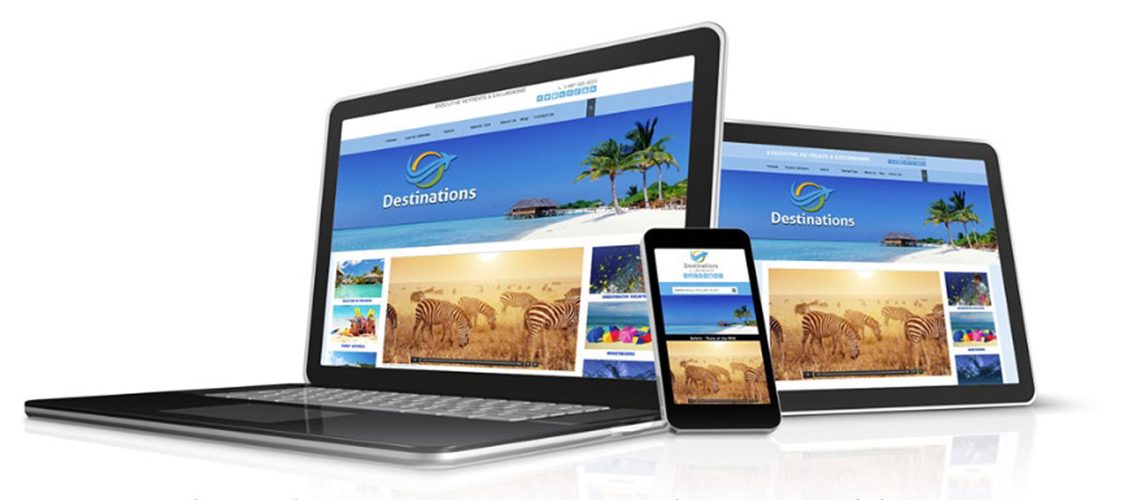Author Amanda Harlech wrote “We have to keep an eye on the future with a sense of the past in every passing moment of the present”. Not only is this prophetic, but to look back with the sole intent of recognizing our origins, we can connect the dots to what might lie ahead.
In technology there is no greater history of evolution than that of the website. The leaps and bounds that have been cast into the realm of “acceptable” to users, has happened as fast as…well…technology.
Let us take a look back at the evolution of the website:
The first website graced us in 1991. It was comprised of all text. Remember that “high-speed Internet” was quite a ways off, so these sites were built light and ready for those painfully slow dial up speeds.
The mid-90’s brought us graphics including the animated GIF. Mid-90’s websites were all about design with columns, rows, navigation elements, and JavaScript enabled scrolling text, all aimed to knock our socks off…and they did!
The late-90’s began to focus on the visitor. Flash made its appearance, enabling more sophisticated animation. Due to its ubiquitous browser support, Flash also was used to launch video playback. The use of 3D buttons came about along with bright color changes. Of course with Flash came huge, mid boggling splash pages with animated images and complex navigation.
The early 2000’s hurdled us into the now! Design became the name of the game and the focus was driven with CSS (cascading style sheets). Developers became interested in predicting the users next move.
The mid-2000’s gave us more mature interactivity, a crucial component of the modern websites of today. Web 2.0 was introduced which allowed users to interact with each other. The focus of these websites was SEO (search engine optimization) which focused on getting your site seen by carefully placed words and sentences.
An interesting dichotomy occurred in November 2011. This was the starting line for the death march of Flash as Steve Jobs declared that Apple would no longer support the Adobe product.
That brings us to today. Today’s CMS (content management system) based website is now appearing more minimalistic, partly due to WordPress templates and other easy to manage solutions. Relevant content is king, while graphics in some cases have been relegated to flat art, leaving room for a new wave of art direction.
The website today focuses on two components:
- UX-The user experience is the foundation of any websites success.
- Mobile Technology-Websites need to be responsive.
So what is a modern website?
A modern website can best be defined by looking at the individual attributes:
- HTML5 and CSS These are the core technologies for building a modern website. They allow function that is easily readable by users and consistently understood by devices.
- Responsive Design This is huge. Websites need to be able to move seamlessly between multiple devices. This is an art that will be noticed by any person that has navigated the same website from their desktop, phone and tablet, and believe it or not, this feature can keep a user on your site, or show them the exit. International Data Corporation Market Research projects that by 2015; more Americans will access the Internet through mobile devices than through desktop computers.
- Parallax Scrolling Jack Roscoe of Design Principals describes parallax scrolling as “creating the illusion of depth in a 2D environment by moving two or more objects simultaneously at different velocities”.
- Video Flash has become a bit of a lame duck in the online space. Video is the shining star now, but we are not talking about your father’s postage stamped sized media player from the nineties. Service providers and CDN’s (content delivery networks) are providing improved connection speed and playback. Properly produced and placed video will capture your audience and get them to stay. Live streaming and interactive video is where websites are headed. Be ahead of this curve in the road or you might get stuck on an old path.
- Inbound Website If you don’t know this term by now, you will certainly be seeing this a lot moving forward. This is the now and the future of marketing:
- Calls To Action (CTA’s): Drive traffic to your lead generating landing pages.
- Landing page & forms: Every campaign you run should be tied to a custom-landing page. Not just another homepage where visitors have to guess where to go next. Forms will gather appropriate information at every stage to unlock the next offer.
- Personalization: people are more than anonymous page views. Smart Content is a feature that enables you to personalize your content to different visitors.
- Integration with marketing channels:Every marketing tool from Content tools, social media, marketing automation and analytics are all deeply cooperative and connected to a marketer’s contact database. This allows for a complete history of your leads interests and interactions, enabling personalization throughout your marketing.
Your modern website needs all of these.
The short version of the methodology is this: It is time to stop waving your hands with an outbound approach to marketing and time to start creating quality content to attract customers to you. Your website should have actionable tips and best practices, SEO rankings (to the standards of today) that will increase site visitors and a boost your social presence.
Google is constantly updating its algorithms. These algorithms decide if your website is ranking second or sixty-second in the organic Google results. Making sure that your website conforms to the outline of “modern” will help you from any unnecessary penalties.
So this is what the modern website looks like. We can clearly see ahead simply by looking back, and while we cannot fully fill in every blank by the capabilities of the website of the future we know that there are vital features needed today that can set us all up for great success tomorrow.
Subscribe to our BLOG
Stay in touch & learn how to attract customers, become a thought leader, create effective marketing campaigns, & more.





